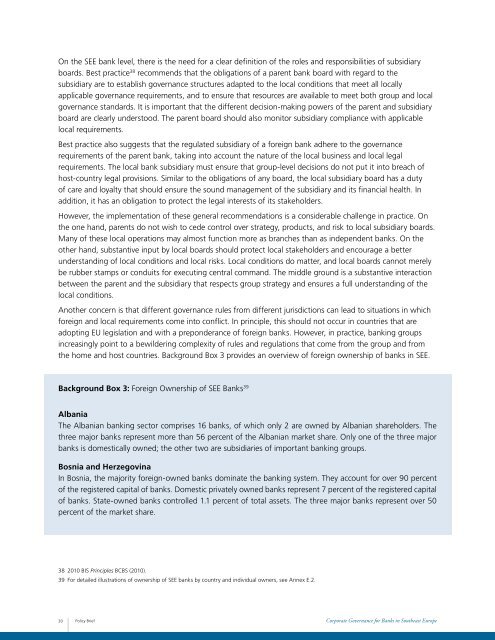Corporate Governance for Banks in Southeast Europe: Policy - IFC
Corporate Governance for Banks in Southeast Europe: Policy - IFC
Corporate Governance for Banks in Southeast Europe: Policy - IFC
Create successful ePaper yourself
Turn your PDF publications into a flip-book with our unique Google optimized e-Paper software.
On the SEE bank level, there is the need <strong>for</strong> a clear def<strong>in</strong>ition of the roles and responsibilities of subsidiary<br />
boards. Best practice 38 recommends that the obligations of a parent bank board with regard to the<br />
subsidiary are to establish governance structures adapted to the local conditions that meet all locally<br />
applicable governance requirements, and to ensure that resources are available to meet both group and local<br />
governance standards. It is important that the different decision-mak<strong>in</strong>g powers of the parent and subsidiary<br />
board are clearly understood. The parent board should also monitor subsidiary compliance with applicable<br />
local requirements.<br />
Best practice also suggests that the regulated subsidiary of a <strong>for</strong>eign bank adhere to the governance<br />
requirements of the parent bank, tak<strong>in</strong>g <strong>in</strong>to account the nature of the local bus<strong>in</strong>ess and local legal<br />
requirements. The local bank subsidiary must ensure that group-level decisions do not put it <strong>in</strong>to breach of<br />
host-country legal provisions. Similar to the obligations of any board, the local subsidiary board has a duty<br />
of care and loyalty that should ensure the sound management of the subsidiary and its f<strong>in</strong>ancial health. In<br />
addition, it has an obligation to protect the legal <strong>in</strong>terests of its stakeholders.<br />
However, the implementation of these general recommendations is a considerable challenge <strong>in</strong> practice. On<br />
the one hand, parents do not wish to cede control over strategy, products, and risk to local subsidiary boards.<br />
Many of these local operations may almost function more as branches than as <strong>in</strong>dependent banks. On the<br />
other hand, substantive <strong>in</strong>put by local boards should protect local stakeholders and encourage a better<br />
understand<strong>in</strong>g of local conditions and local risks. Local conditions do matter, and local boards cannot merely<br />
be rubber stamps or conduits <strong>for</strong> execut<strong>in</strong>g central command. The middle ground is a substantive <strong>in</strong>teraction<br />
between the parent and the subsidiary that respects group strategy and ensures a full understand<strong>in</strong>g of the<br />
local conditions.<br />
Another concern is that different governance rules from different jurisdictions can lead to situations <strong>in</strong> which<br />
<strong>for</strong>eign and local requirements come <strong>in</strong>to conflict. In pr<strong>in</strong>ciple, this should not occur <strong>in</strong> countries that are<br />
adopt<strong>in</strong>g EU legislation and with a preponderance of <strong>for</strong>eign banks. However, <strong>in</strong> practice, bank<strong>in</strong>g groups<br />
<strong>in</strong>creas<strong>in</strong>gly po<strong>in</strong>t to a bewilder<strong>in</strong>g complexity of rules and regulations that come from the group and from<br />
the home and host countries. Background Box 3 provides an overview of <strong>for</strong>eign ownership of banks <strong>in</strong> SEE.<br />
Background Box 3: Foreign Ownership of SEE <strong>Banks</strong> 39<br />
Albania<br />
The Albanian bank<strong>in</strong>g sector comprises 16 banks, of which only 2 are owned by Albanian shareholders. The<br />
three major banks represent more than 56 percent of the Albanian market share. Only one of the three major<br />
banks is domestically owned; the other two are subsidiaries of important bank<strong>in</strong>g groups.<br />
Bosnia and Herzegov<strong>in</strong>a<br />
In Bosnia, the majority <strong>for</strong>eign-owned banks dom<strong>in</strong>ate the bank<strong>in</strong>g system. They account <strong>for</strong> over 90 percent<br />
of the registered capital of banks. Domestic privately owned banks represent 7 percent of the registered capital<br />
of banks. State-owned banks controlled 1.1 percent of total assets. The three major banks represent over 50<br />
percent of the market share.<br />
38 2010 BIS Pr<strong>in</strong>ciples BCBS (2010).<br />
39 For detailed illustrations of ownership of SEE banks by country and <strong>in</strong>dividual owners, see Annex E.2.<br />
30<br />
<strong>Policy</strong> Brief<br />
<strong>Corporate</strong> <strong>Governance</strong> <strong>for</strong> <strong>Banks</strong> <strong>in</strong> <strong>Southeast</strong> <strong>Europe</strong>

















